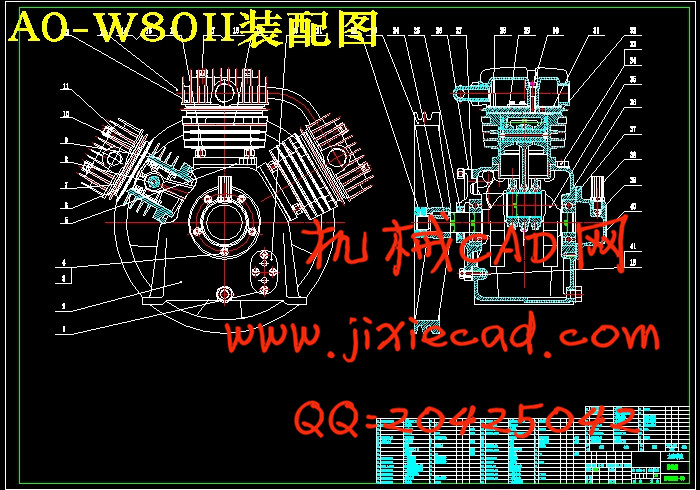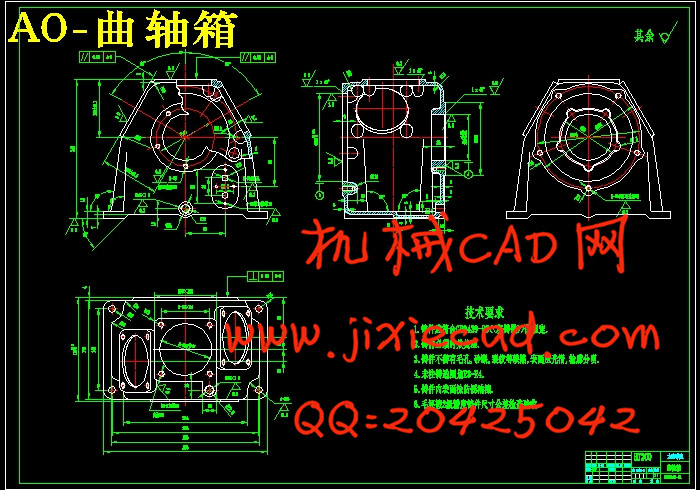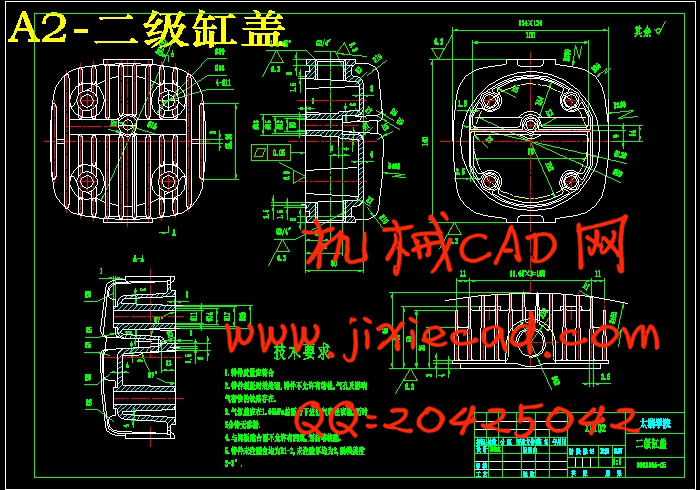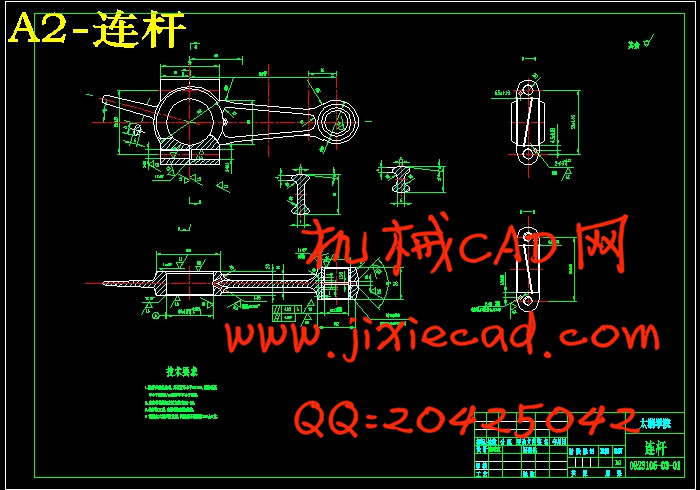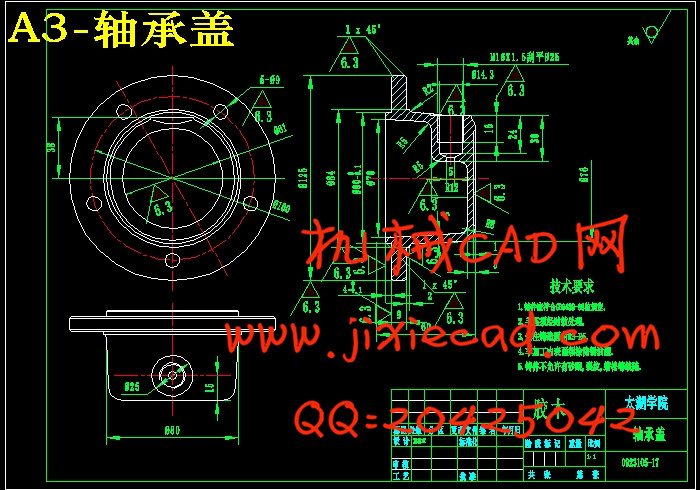设计简介
摘 要
活塞式压缩机是一种容积式压缩机,用来提高气体压力和传送气体,目前广泛用于工业生产中,例如:石油、化工、冶金、轻功、纺织、及采矿等。因此,气体压缩机是近代工业生产中不可缺少的通用机械。结合所学过的中小型压缩机,了解其基本结构及其工作原理,重点掌握其结构设计学会所含零部件的结构设计方法及其强度校核方法,在设计过程中,理论联系实际,最终了解设计一个机械设备基本思想和方法。
W型风冷微型活塞式压缩机主要用于工业中气体压缩,虽然其结构有别于其他压缩机,但它们原理相似。因此可以根据已知的压缩机类型,通过互相比较进而进行设计。
整个设计过程包括整体总体结构设计、热力学的计算、初定相关零部件结构尺寸,然后借助CAXA等绘图软件,选定轴承等标准件,应用强度理论对其进行必要的强度校核以满足实际的需要,最后确定压缩机的辅助设备。
关键字:活塞式压缩机;强度校核;行程容积;动力计算
W-type air-cooled micro-piston compressor is mainly used for industry, gas compression, although its structure is different from other compressor, but they are similar in principle. Therefore it can be known according to the type of the compressor, by mutual comparison Further design.
Throughout the design process, including overall design of the overall structure, thermodynamic calculations, an initial component structure size CAXA and other graphics software, and then with the selected bearings and other standard parts, application strength theory be necessary strength check to meet the actual need to finalize the compressor auxiliary equipment.
Keywords: Piston compressor; Strength check; Stroke volume; Dynamic calculation
目 录
摘 要 III
Abstract IV
目 录 v
1 绪论 1
1.1本课题的研究内容和意义 1
1.2国内外的发展概况 1
1.3本课题应达到的要求 1
2 压缩机总体结构的设计 2
2.1 设计原则及设计任务 2
2.2 结构方案的选择 3
2.3列数及级在列中的配置 4
3 压缩机热力计算 5
3.1 技术参数 5
3.2热力计算 5
3.2.1计算总压力比 5
3.2.2压缩机级数的确定 5
3.2.3压力比分配 5
3.2.4计算容系数 5
3.2.5确定压力系数 6
3.2.6确定温度系数 6
3.2.7计算泄漏系数 6
3.2.8计算气缸工作容积 7
3.2.9确定缸径、行程及行程容积 7
3.2.10复算压比或调整余隙容积 8
3.2.11计算各列最大的活塞力 9
3.2.12计算排气温度 9
3.2.13计算功率 9
3.2.14等温功率 10
4 动力计算 11
4.1已知数据整理 11
4.2动力计算 11
4.2.1计算活塞位移、速度、加速度 11
4.2.2气体力的计算 13
4.2.3惯性力的计算 17
4.2.4切向力的计算及切向力曲线的绘制 21
4.2.5飞轮矩的确定 23
5 主要零部件的分析设计 26
5.1气缸部分的分析计算 26
5.2机身的设计 28
5.2.1机身材料 28
5.2.2主要尺寸确定 29
5.3连杆的设计 29
5.3.1概述 29
5.3.2连杆的结构设计 29
5.3.3杆身结构 29
6 结论与展望 33
6.1 结论 33
6.2不足之处及未来展望 33
致 谢 34
参考文献 35
活塞式压缩机是一种容积式压缩机,用来提高气体压力和传送气体,目前广泛用于工业生产中,例如:石油、化工、冶金、轻功、纺织、及采矿等。因此,气体压缩机是近代工业生产中不可缺少的通用机械。结合所学过的中小型压缩机,了解其基本结构及其工作原理,重点掌握其结构设计学会所含零部件的结构设计方法及其强度校核方法,在设计过程中,理论联系实际,最终了解设计一个机械设备基本思想和方法。
W型风冷微型活塞式压缩机主要用于工业中气体压缩,虽然其结构有别于其他压缩机,但它们原理相似。因此可以根据已知的压缩机类型,通过互相比较进而进行设计。
整个设计过程包括整体总体结构设计、热力学的计算、初定相关零部件结构尺寸,然后借助CAXA等绘图软件,选定轴承等标准件,应用强度理论对其进行必要的强度校核以满足实际的需要,最后确定压缩机的辅助设备。
关键字:活塞式压缩机;强度校核;行程容积;动力计算
Abstract
The piston compressor is a positive displacement compressor used to increase the gas pressure and gas transmission, now widely used in industrial production, such as: petroleum, chemical, metallurgy, dodge, textile, and mining. Therefore, the gas compressor is indispensable in modern industrial production of general machinery. Combined with the small and medium-sized compressor, we understand the basic structure and how it works, focus on mastering the Society of structural design components contained in the structural design method and its strength check method, theory with practice in the design process, the final Learn basic ideas and methods of the design of a mechanical device.W-type air-cooled micro-piston compressor is mainly used for industry, gas compression, although its structure is different from other compressor, but they are similar in principle. Therefore it can be known according to the type of the compressor, by mutual comparison Further design.
Throughout the design process, including overall design of the overall structure, thermodynamic calculations, an initial component structure size CAXA and other graphics software, and then with the selected bearings and other standard parts, application strength theory be necessary strength check to meet the actual need to finalize the compressor auxiliary equipment.
Keywords: Piston compressor; Strength check; Stroke volume; Dynamic calculation
摘 要 III
Abstract IV
目 录 v
1 绪论 1
1.1本课题的研究内容和意义 1
1.2国内外的发展概况 1
1.3本课题应达到的要求 1
2 压缩机总体结构的设计 2
2.1 设计原则及设计任务 2
2.2 结构方案的选择 3
2.3列数及级在列中的配置 4
3 压缩机热力计算 5
3.1 技术参数 5
3.2热力计算 5
3.2.1计算总压力比 5
3.2.2压缩机级数的确定 5
3.2.3压力比分配 5
3.2.4计算容系数 5
3.2.5确定压力系数 6
3.2.6确定温度系数 6
3.2.7计算泄漏系数 6
3.2.8计算气缸工作容积 7
3.2.9确定缸径、行程及行程容积 7
3.2.10复算压比或调整余隙容积 8
3.2.11计算各列最大的活塞力 9
3.2.12计算排气温度 9
3.2.13计算功率 9
3.2.14等温功率 10
4 动力计算 11
4.1已知数据整理 11
4.2动力计算 11
4.2.1计算活塞位移、速度、加速度 11
4.2.2气体力的计算 13
4.2.3惯性力的计算 17
4.2.4切向力的计算及切向力曲线的绘制 21
4.2.5飞轮矩的确定 23
5 主要零部件的分析设计 26
5.1气缸部分的分析计算 26
5.2机身的设计 28
5.2.1机身材料 28
5.2.2主要尺寸确定 29
5.3连杆的设计 29
5.3.1概述 29
5.3.2连杆的结构设计 29
5.3.3杆身结构 29
6 结论与展望 33
6.1 结论 33
6.2不足之处及未来展望 33
致 谢 34
参考文献 35


